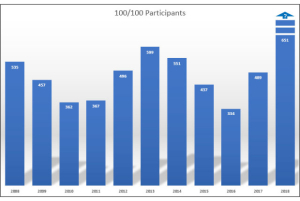Tomorrow, which for many of you will mean today when you read this – and yesterday for some of you – the 100/100 Challenge will start (or is starting; or will have started).
If we're catching you cold, not to worry. You’ve got 100 days to make it right.
As of this writing we’re at right about 400 entrants, each of whom has paid a fee of $0, but for many this will be the most consequential event of the year. The goal is to run 100 times in 100 days or, failing that – and most will fail that – to run as many sessions in the 100 days beginning December 1st as you can (90, 80, 70, 60, whatever you can manage).

You keep track of your progress here, on the Slowtwitch Training Log (where you’ll see your place in the standings). You’ll talk smack here, on our Reader Forum (or give encouragement, or receive it). The rules are right there on the first post of that discussion thread.
You’ll need a Forum User account. Get one if you don’t have one. We ask a question during registration, to weed out the spammers. If you answer 100/100 to that question then I’ll know to validate your account.
If I can, as a competitive runner celebrating 50 years in that avocation, give you the following advice:
The Goal of Today’s Run: …Is Tomorrow’s Run. Treat every run as if the goal was living to run another day. And another. And another. You may find this difficult, because for many of us the goal of every run is to squeeze every drop of juice out of it. Put that urge off until the Spring. Imagine what it would be like to do your hell-bent-for-leather runs after having just put 100 consecutive days of running in the bank!
Learn What Barfoot Running Teaches Us: …Without doing any of it! As a devotee of cushion, of course I’m not a fan of barefoot. But there’s a lesson to be learned. Running barefoot, or aboard just an outsole (Vibram 5 Fingers, or a Tarahumara-style huarache sandal) is painful unless you run with a good footfall, and an optimized technique. In my opinion, the reason many users of cushioned run shoes still have injury problems is cushioning makes it easier to run badly. I laugh when I hear documentarians wax elegiac on the stylized form of the Tarahumara runners. They simply run with an economy of motion that very good runners employ, regardless of their shoes or their nationalities. Point being: You’re about to try to run something like an ultramarathon. Just, instead of running it all at once, you’re going to spread it out, a little each day, for 100 days. Make running with that economy of motion an imperative, from day-1.

The Treadmill as a Run Form Tool: About that point on economy of motion… the treadmill is one pretty good tool for this. If you’ll do any of your runs on a treadmill, here’s a kind of drill: When you’ve warmed up to a decent pace – and don’t make this a fast pace, but just an easy conversational speed – experiment with just how little force you can place on your feet as you contact the mill. The mill’s job is to keep the pace. Your job is to figure out how to run that pace with the most ease, the least exertion, the most relaxation, the least force applied. This probably means a quicker tempo, and a footplant just below the knee (not in front of it). Want to learn quickly how to run with great economy of motion? Run barefoot. Want to learn it more quickly? Run barefoot over terrain that will abuse your feet. What to learn it quicker yet? Run over broken glass. Of course I’m being facetious. The point is to run as if you were running barefoot, but without running barefoot. That’s how you make it from one day to the next in this Challenge.
That’s it! Above is the sum of my wisdom. Bon Chance to you all!



